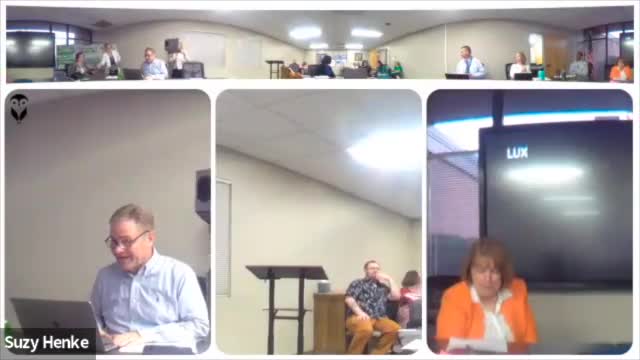Ohio School Funding Review Highlights Budget Disparities and New Proposals
April 23, 2025 | Wyoming City, School Districts, Ohio
This article was created by AI summarizing key points discussed. AI makes mistakes, so for full details and context, please refer to the video of the full meeting. Please report any errors so we can fix them. Report an error »

In the dimly lit conference room of Wyoming City Schools, the air was thick with anticipation as school board members gathered to discuss the pressing issue of the state biennium budget. The meeting, held on April 23, 2025, focused on the implications of the budget for public school funding in Ohio, particularly for the Wyoming district, which has faced stagnant state funding since fiscal year 2019.
The discussion began with an overview of the biennial budget process, emphasizing the urgency of understanding the current fiscal landscape as the state prepares to transition into the next budget cycle. The district's financial health hinges on three primary revenue sources: real estate taxes, income tax, and state funding, which collectively amount to approximately $5.5 million. However, the stark reality is that state funding has remained flat for six consecutive years, raising concerns about the sustainability of educational resources.
A significant point of contention was the implementation of the Fair School Funding Plan, which was intended to provide a more equitable distribution of funds across Ohio's 612 public school districts. Despite the plan's promise, Wyoming has not seen any additional revenue, remaining on a funding guarantee that has not improved its financial situation. The district's representatives highlighted that while the state has managed to increase funding for other sectors, such as healthcare, public education continues to struggle.
As the meeting progressed, the board examined the various proposals from Governor DeWine, the Ohio House, and the Senate, noting that each version of the budget presents different implications for school funding. The governor's proposal, which suggested reducing the funding guarantee and adjusting capacity measures, was met with skepticism. The board expressed concern that these changes would further disadvantage districts like Wyoming, which already receive less state support compared to their peers.
The House's proposal offered a glimmer of hope with a slight increase in funding for public schools, but it came with the caveat of a new cash balance provision. This provision could lead to reductions in property tax revenue if the district's cash reserves exceed a certain threshold, potentially undermining the financial stability that the district has worked hard to maintain.
The board members voiced their apprehensions about the future, particularly regarding the potential need for new operating levies to sustain educational programs. The looming threat of reduced funding and increased reliance on local taxpayers could create a cycle of financial instability, forcing the district to return to voters more frequently for support.
As the meeting drew to a close, the representatives acknowledged the importance of continued advocacy at the state level. With the Senate hearings on the budget approaching, they emphasized the need for a unified voice to ensure that the needs of Wyoming City Schools are not overlooked in the final budget negotiations. The outcome of these discussions will not only shape the financial future of the district but also impact the quality of education for the students it serves.
The discussion began with an overview of the biennial budget process, emphasizing the urgency of understanding the current fiscal landscape as the state prepares to transition into the next budget cycle. The district's financial health hinges on three primary revenue sources: real estate taxes, income tax, and state funding, which collectively amount to approximately $5.5 million. However, the stark reality is that state funding has remained flat for six consecutive years, raising concerns about the sustainability of educational resources.
A significant point of contention was the implementation of the Fair School Funding Plan, which was intended to provide a more equitable distribution of funds across Ohio's 612 public school districts. Despite the plan's promise, Wyoming has not seen any additional revenue, remaining on a funding guarantee that has not improved its financial situation. The district's representatives highlighted that while the state has managed to increase funding for other sectors, such as healthcare, public education continues to struggle.
As the meeting progressed, the board examined the various proposals from Governor DeWine, the Ohio House, and the Senate, noting that each version of the budget presents different implications for school funding. The governor's proposal, which suggested reducing the funding guarantee and adjusting capacity measures, was met with skepticism. The board expressed concern that these changes would further disadvantage districts like Wyoming, which already receive less state support compared to their peers.
The House's proposal offered a glimmer of hope with a slight increase in funding for public schools, but it came with the caveat of a new cash balance provision. This provision could lead to reductions in property tax revenue if the district's cash reserves exceed a certain threshold, potentially undermining the financial stability that the district has worked hard to maintain.
The board members voiced their apprehensions about the future, particularly regarding the potential need for new operating levies to sustain educational programs. The looming threat of reduced funding and increased reliance on local taxpayers could create a cycle of financial instability, forcing the district to return to voters more frequently for support.
As the meeting drew to a close, the representatives acknowledged the importance of continued advocacy at the state level. With the Senate hearings on the budget approaching, they emphasized the need for a unified voice to ensure that the needs of Wyoming City Schools are not overlooked in the final budget negotiations. The outcome of these discussions will not only shape the financial future of the district but also impact the quality of education for the students it serves.
View full meeting
This article is based on a recent meeting—watch the full video and explore the complete transcript for deeper insights into the discussion.
View full meeting
